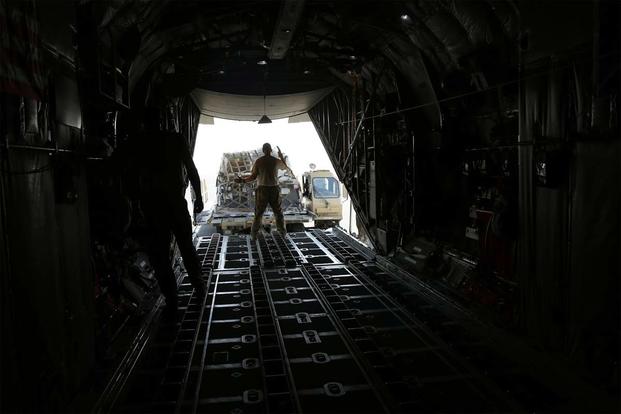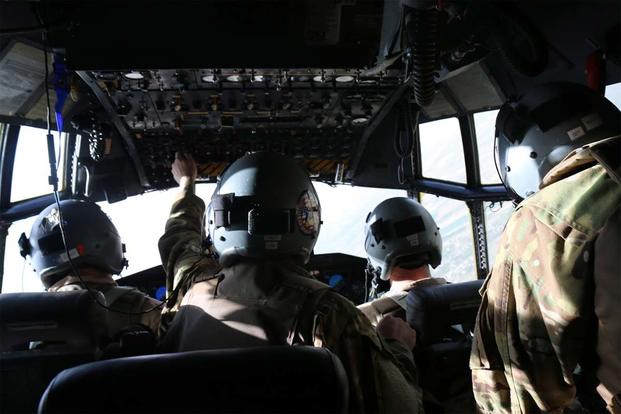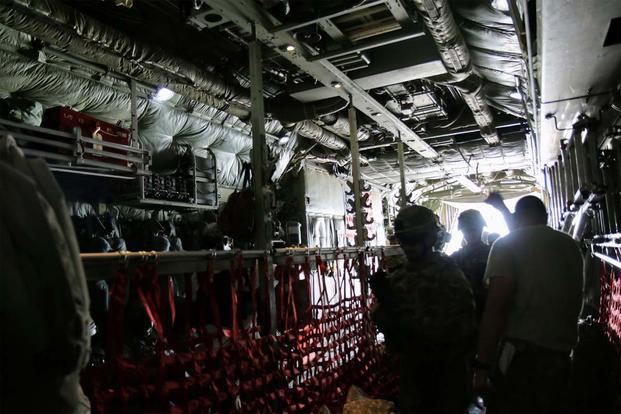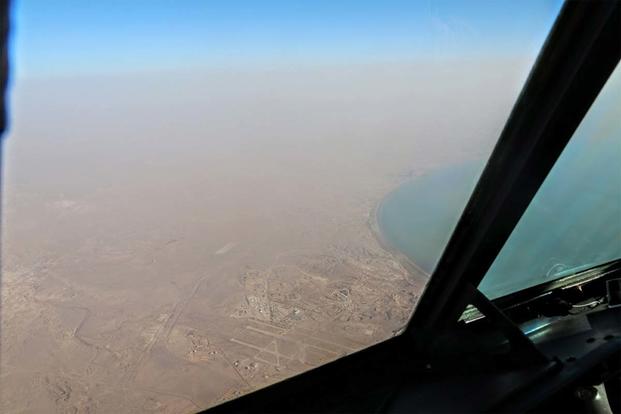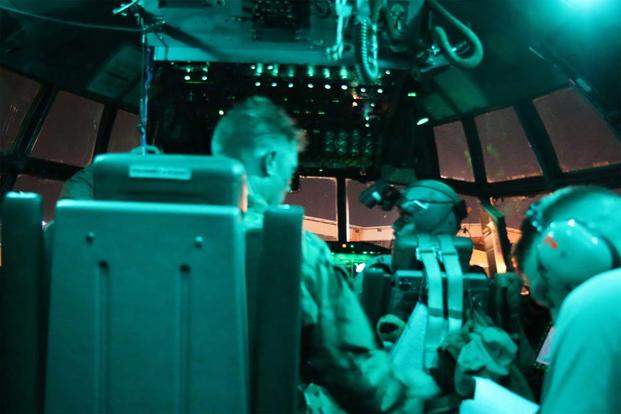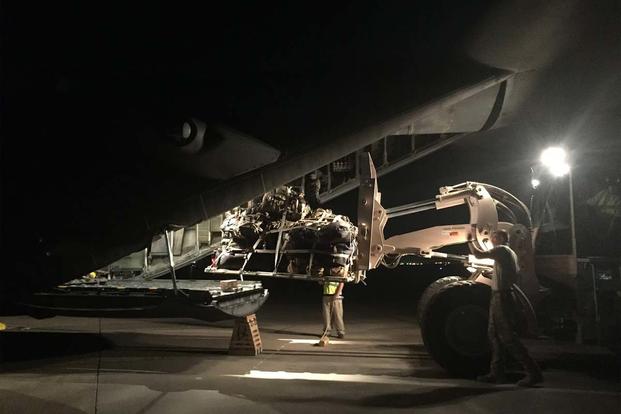ABOARD A US MILITARY AIRCRAFT OVER IRAQ -- The 386th Air Expeditionary Wing's C-130 Hercules mission may not be the most glamorous part of the U.S. military's fight against the Islamic State, but it's vital.
During a single mission on Wednesday, a crew of six moved nearly 100 people including special operations forces, allies and civilians -- and roughly 15 tons of cargo such as ammunition, tactical equipment, building materials, fuel, food, blood packs.
Military.com joined the C-130H3's 12-hour operation to several locations in Iraq. The 386th, based elsewhere in Southwest Asia, invited this reporter along under the condition last names, specific locations, tactics and procedures not be disclosed.
Related content:
- General: US Pilots Made the Call to Shoot Down Syrian Aircraft
- Why the F-22 Raptor Didn't Get the Air-to-Air Kill in Syria
- The F-22 in Syria: Deconflicting, not Dog-Fighting
"I would say the C-130 -- we're more like the blue collar guys of Air Force [operations]," Capt. Dennis, the co-pilot, said during the mission.
"We bring our lunch pail to work every day, punch in the timecard, and get the mission done," said Dennis, who, if it were standard for non-combat pilots to have a call sign, said he'd be called "Thundercat."
The crew for Wednesday's flight included pilots, a navigator, a flight engineer and loadmasters, all of whom hailed from the National Guard's 156th Airlift Squadron in Charlotte, North Carolina. In theater, they're part of the 737th Expeditionary Airlift Squadron. The mission was their last in the Middle East before returning home.
"There's nothing holding us back when we're out here," said Tech. Sgt. Justin, the flight engineer.
"We're always doing something," added Capt. Ashley, the navigator. "Really, the C-130 is out helping people, and that's why I love being a part of this mission."
Flying east, the crew watched out the C-130's front windows for anything suspicious as the Hercules descended. Before landing, they suited up with protective armor, per protocol.
"Welcome to Iraq," Ashley said.
Complex Theater
Despite the complexity of the fight against ISIS and, in Syria, the uncertainties surrounding how the U.S. will respond to pro-Syrian regime forces moving forward -- the crew pressed on.
"We try not to pay attention, to be honest," said Ashley, when asked if the latest U.S. "red line" comment against Syria worried the crew.
President Donald Trump's administration a day earlier announced it was conceiving a potential targeted response against President Bashar al-Assad, saying it was aware that "potential preparations for another chemical weapons attack" were looming.
"Our missions go on more than anyone else's do," Justin said. Officials said there has not been "any stoppage" on airlift in areas near contested airspace.
However, tasking for flights can change rapidly, even in the air.
"Stuff pops up, and we deal with it as it comes," said Maj. Joe, the crew's mission commander and pilot.
"It's a complex environment," said Col. Charles D. Bolton, the 386th commander. "We fly with the same defense systems we've had for a while. We're trained to operate in this environment and have been for many, many years."
And that's due to the C-130's tactical advantage. Much more flexible and agile than its larger cousin, the C-17 Globemaster III, the Lockheed Martin Corp.-made C-130s can carry approximately 45,000 pounds and airdrop loads up to 42,000 pounds.
Roughly 50 years old -- depending on model -- the planes carry decoy flares. When launched by the automatic system that detects a threat, the flare draws a rocket to lock onto it instead of the aircraft. There are also internal armored panels throughout the floors and sides of the craft to provide additional protection.
"For us, there's nothing different. We haven't had anything [happen] to our aircraft," Bolton continued. "This is what we do. We're going to fly and do what we do every day."
When asked about the seemingly fluid "deconfliction zone" in Syria, he said there are higher-threat areas the C-130's will logically avoid.
"We generally don't go 'downtown' as what we call it," Bolton said. "We might be tasked to, and if we are, that will be thought out and planned appropriately."
The 156th crew said they've been part of airdrops supplying U.S.-backed forces on the frontlines in Syria.
"I prefer to fly into Iraq as opposed to Syria for combat support -- but that's just my preference," Joe said.
Even so, Joe said he enjoys doing airdrops -- less prevalent than standard transport -- because C-130 crews "spend so much time training for them, and it's good to see operationally."
"This is, after all, a combat-focused mission," he said.
And that's how any aviation crew should see it, Bolton said. "When you go … to fly every day, you're thinking, 'This is war, This is combat.' "
A Clear-Focused Run
Before this particular flight began, a crew member recited a favorite quote that "brings them inspiration," per the crew's tradition. Staff Sgt. Cody, a loadmaster, chose the speech President Thomas Whitmore -- played by Bill Pullman -- famously made in the film "Independence Day."
It was the crew's own good-luck juju, which held through the hours-long flight to a handful of locations, and the last to close out their four-month deployment.
As the sun went down, the onboard dynamic changed slightly. The C-130 went dark. The crew strapped into armor, and night-vision goggles came on. Only a blanket of fires from Iraqis below and stars from above lit the way forward.
Approaching the last strip, the crew went silent, watching for movement from Islamic State forces on the ground, and also coalition aircraft from any direction. The airspace was busy but not overwhelming, with aircraft such as coalition drones and aerostats.
The crew still carefully changed altitudes or directions as needed.
"We're used to this," Joe said.
The final load of the night went out under dim lights. Before taking off again, they saw a rocket flare launched from some miles away. "I don't know what that was," Joe said but said it happens from time to time as ISIS has been known to operate in the area.
On the return trip, flight engineer Justin had one more mission -- to re-enlist aboard the aircraft in Iraqi airspace. The 16-year Air Force veteran put in for at least four more years. Dennis administered the oath.
"I know 100 percent this is my last" re-enlistment, Justin said. "Mainly because I hate every second I have to be away from my kids. [Still] it is the best when it is just the six of us [crew] doing what we gotta do," he said.
Ashley said, "What makes mobility stand out is we flex to what the need is. We have the opportunity out here to do something on the edge of what C-130s are capable of doing -- that's something."
-- Oriana Pawlyk can be reached at oriana.pawlyk@military.com. Follow her on Twitter at @Oriana0214.

